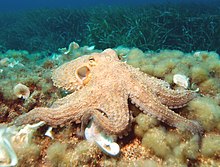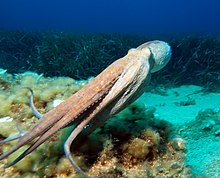| Octopus Temporal range: 323.2 – 0 Ma Late Carboniferous – recent | |
|---|---|
 | |
| Common octopus |
The octopus (/ˈɒktəpəs/ or ~/pʊs/) is a soft-bodied, eight-armed mollusc of the orderOctopoda. Around 300 species are recognised and the order is grouped within the class Cephalopoda with squids, cuttlefish and nautiloids. Like other cephalopods, the octopus is bilaterally symmetric with two eyes and a beak, with its mouth at the centre point of the arms (which are sometimes mistakenly called "tentacles"). The soft body can rapidly alter its shape, enabling octopuses to squeeze through small gaps. They trail their eight arms behind them as they swim. The siphon is used both for respiration and for locomotion, by expelling a jet of water. Octopuses have a complex nervous system and excellent sight, and are among the most intelligent and behaviourally diverse of all invertebrates.
Octopuses inhabit various regions of the ocean, including coral reefs, pelagic waters, and the seabed; some live in the intertidal zone and others at abyssal depths. Most species grow fast, mature early and are short-lived. During breeding, the male uses a specially adapted arm to deliver a bundle of sperm directly into the female's mantle cavity, after which he becomes senescent and dies. The female deposits fertilised eggs in a den and cares for them until they hatch, after which she also dies.
Strategies to defend themselves against predators include the expulsion of ink, the use of camouflage and threat displays, their ability to jet quickly through the water, and their ability to hide. All octopuses are venomous, but only the blue-ringed octopuses are known to be deadly to humans.
Octopuses appear in mythology as sea monsters like the Kraken of Norway and the Akkorokamui of the Ainu, and probably the Gorgon of ancient Greece. A battle with an octopus appears in Victor Hugo's book Toilers of the Sea, inspiring other works such as Ian Fleming's Octopussy. Octopuses appear in Japanese erotic art, shunga. They are eaten by humans in many parts of the world, especially the Mediterranean and the Asian seas....
...
Octopuses have a relatively short life expectancy; some species live for as little as six months. The giant Pacific octopus, one of the two largest species of octopus, may live for as much as five years. Octopus lifespan is limited by reproduction: males can live for only a few months after mating, and females die shortly after their eggs hatch. Octopus reproductive organs mature due to the hormonal influence of the optic gland but result in the inactivation of their digestive glands, typically causing the octopus to eventually die from starvation.[63]:276–277 Experimental removal of both optic glands after spawning was found to result in the cessation of broodiness, the resumption of feeding, increased growth, and greatly extended lifespans.[64]
Distribution and habitat
Octopuses live in every ocean, and different species have adapted to different marine habitats. As juveniles, common octopuses inhabit shallow tide pools. The Hawaiian day octopus (Octopus cyanea) lives on coral reefs; argonauts drift in pelagic waters. Abdopus aculeatus mostly lives in near-shore seagrass beds. Some species are adapted to the cold, ocean depths. The spoon-armed octopus (Bathypolypus arcticus) is found in abyssal plains at depths of 1,000 m (3,300 ft), and Vulcanoctopus hydrothermalis lives near hydrothermal vents at 2,000 m (6,600 ft).[24] The cirrate species are often free-swimming and live in deep-water habitats.[32] No species are known to live in fresh water.[65]
Behaviour and ecology
Most species are solitary when not mating,[66] though a few are known to occur in high densities and with frequent interactions, signaling, mate defending and eviction of individuals from dens. This is likely the result of abundant food supplies combined with limited den sites.[67] Octopuses hide in dens, which are typically crevices in rocky outcrops or other hard structures, though some species burrow into sand or mud. Octopuses are not territorial but generally remain in a home range; they may leave the area in search of food. They can use navigation skills to return to a den without having to retrace their outward route.[68] They are not known to be migratory.[69]
Octopuses bring captured prey back to the den where they can eat it safely. Sometimes the octopus catches more prey than it can eat, and the den is often surrounded by a midden of dead and uneaten food items. Other creatures, such as fish, crabs, molluscs and echinoderms, often share the den with the octopus, either because they have arrived as scavengers, or because they have survived capture.[70]
Feeding
Nearly all octopuses are predatory; bottom-dwelling octopuses eat mainly crustaceans, polychaete worms, and other molluscs such as whelks and clams; open-ocean octopuses eat mainly prawns, fish and other cephalopods.[71] Major items in the diet of the giant Pacific octopus include bivalve molluscs such as the cockle Clinocardium nuttallii, clams and scallops, and crustaceans such as crabs and spider crabs. Prey that it is likely to reject include moon snails, because they are too large, and limpets, rock scallops, chitons and abalone, because they are too securely fixed to the rock.[70]
A bottom-dwelling octopus typically moves among the rocks and feels through the crevices. The creature may make a jet-propelled pounce on prey and pull it towards the mouth with its arms, the suckers restraining it. Small prey may be completely trapped by the webbed structure. Octopuses usually inject crustaceans like crabs with a paralysing saliva then dismember them with their beaks.[71][72] Octopuses feed on shelled molluscs either by forcing the valves apart, or by drilling a hole in the shell to inject a nerve toxin.[73][72] It used to be thought that the hole was drilled by the radula, but it has now been shown that minute teeth at the tip of the salivary papilla are involved, and an enzyme in the toxic saliva is used to dissolve the calcium carbonate of the shell. It takes about three hours for O. vulgaris to create a 0.6 mm (0.024 in) hole. Once the shell is penetrated, the prey dies almost instantaneously, its muscles relax, and the soft tissues are easy for the octopus to remove. Crabs may also be treated in this way; tough-shelled species are more likely to be drilled, and soft-shelled crabs are torn apart.[74]
Some species have other modes of feeding. Grimpoteuthis has a reduced or non-existent radula and swallows prey whole.[31] In the deep-sea genus Stauroteuthis, some of the muscle cells that control the suckers in most species have been replaced with photophores which are believed to fool prey by directing them towards the mouth, making them one of the few bioluminescentoctopuses.[75]
Locomotion
Octopuses mainly move about by relatively slow crawling, with some swimming in a head-first position. Jet propulsion, or backwards swimming, is their fastest means of locomotion, followed by swimming and crawling.[76] When in no hurry, they usually crawl on either solid or soft surfaces. Several arms are extended forwards, some of the suckers adhere to the substrate and the animal hauls itself forwards with its powerful arm muscles, while other arms may push rather than pull. As progress is made, other arms move ahead to repeat these actions and the original suckers detach. During crawling, the heart rate nearly doubles, and the animal requires ten or fifteen minutes to recover from relatively minor exercise.[27]
Most octopuses swim by expelling a jet of water from the mantle through the siphon into the sea. The physical principle behind this is that the force required to accelerate the water through the orifice produces a reaction that propels the octopus in the opposite direction.[77] The direction of travel depends on the orientation of the siphon. When swimming, the head is at the front and the siphon is pointed backwards, but when jetting, the visceral hump leads, the siphon points towards the head and the arms trail behind, with the animal presenting a fusiform appearance. In an alternative method of swimming, some species flatten themselves dorso-ventrally, and swim with the arms held out sideways, and this may provide lift and be faster than normal swimming. Jetting is used to escape from danger, but is physiologically inefficient, requiring a mantle pressure so high as to stop the heart from beating, resulting in a progressive oxygen deficit.[76]
Cirrate octopuses cannot produce jet propulsion and rely on their fins for swimming. They have neutral buoyancy and drift through the water with the fins extended. They can also contract their arms and surrounding web to make sudden moves known as "take-offs". Another form of locomotion is "pumping", which involves symmetrical contractions of muscles in their webs producing peristaltic waves. This moves the body slowly.[31]
In 2005, Adopus aculeatus and veined octopus (Amphioctopus marginatus) were found to walk on two arms, while at the same time mimicking plant matter.[78] This form of locomotion allows these octopuses to move quickly away from a potential predator without being recognised.[76] A study of this behaviour led to the suggestion that the two rearmost appendages may be more accurately termed "legs" rather than "arms".[79] Some species of octopus can crawl out of the water briefly, which they may do between tide pools while hunting crustaceans or gastropods or to escape predators.[80][81]"Stilt walking" is used by the veined octopus when carrying stacked coconut shells. The octopus carries the shells underneath it with two arms, and progresses with an ungainly gait supported by its remaining arms held rigid.[82]
Intelligence
Octopuses are highly intelligent, but the extent of their intelligence and learning capability are not well defined.[83][84][85][86] Maze and problem-solving experiments have shown evidence of a memory system that can store both short- and long-term memory. It is not known precisely what contribution learning makes to adult octopus behaviour. Young octopuses learn nothing from their parents, as adults provide no parental care beyond tending to their eggs until the young octopuses hatch.[57]:75
In laboratory experiments, octopuses can be readily trained to distinguish between different shapes and patterns. They have been reported to practise observational learning,[87] although the validity of these findings is contested.[83][84] Octopuses have also been observed in what has been described as play: repeatedly releasing bottles or toys into a circular current in their aquariums and then catching them.[88] Octopuses often break out of their aquariums and sometimes into others in search of food.[80][89][90] They have even boarded fishing boats and opened holds to eat crabs.[85] The veined octopus collects discarded coconut shells, then uses them to build a shelter, an example of tool use.[82][91][92]
Camouflage and colour change
Octopuses use camouflage when hunting, and to avoid predators. To do this they use specialised skin cells which change the appearance of the skin by adjusting its colour, opacity, or reflectivity. Chromatophores contain yellow, orange, red, brown, or black pigments; most species have three of these colours, while some have two or four. Other colour-changing cells are reflective iridophores and white leucophores.[93] This colour-changing ability is also used to communicate with or warn other octopuses.[94]
Octopuses can create distracting patterns with waves of dark coloration across the body, a display known as the "passing cloud". Muscles in the skin change the texture of the mantle to achieve greater camouflage. In some species, the mantle can take on the spiky appearance of algae; in others, skin anatomy is limited to relatively uniform shades of one colour with limited skin texture. Octopuses that are diurnal and live in shallow water have evolved more complex skin than their nocturnal and deep-sea counterparts.[94....








No comments:
Post a Comment